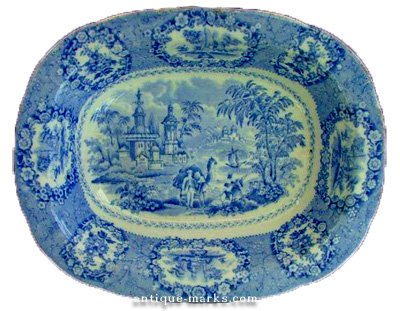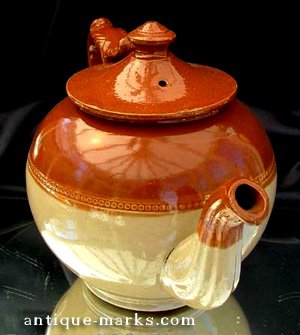Are Spode Potery By Turner Worth Any Money
Contents
- Go to know your antique porcelain collectibles by learning to recognise Staffordshire porcelain.
- Staffordshire porcelain is essentially all the higher up.
- The Origins of Porcelain in Staffordshire.
- Early on English porcelain was a basic can-glazed formulation called Delftware.
- Style Developed in Staffordshire
- Porcelain makers loved Menses Blue.
- Major Staffordshire Porcelain Maufacturers.
- Some of the other famous Staffordshire names include:
- Most of these Staffordshire potters contributed major accomplishments to the development of English porcelain
- Some of the other famous Staffordshire names include:
- Staffordshire Pottery Marks
- The Origin of the Staffordshire Knot
- Then, as y'all can see, the name Staffordshire tin can correspond many areas in antique porcelain collecting.
- The Origin of the Staffordshire Knot
Get to know your antiquarian porcelain collectibles by learning to recognise Staffordshire porcelain.

Near people take probably heard of Staffordshire Porcelain, and most vintage and antique porcelain collectors are probably familiar with the name.
Just, just what does Staffordshire mean when you're talking about pottery & porcelain?
Is information technology a company name? Is it a style, or type of porcelain? Is it but a region that porcelain comes from? Or could the reply be all of the in a higher place?
This is information every smashing porcelain collector should know.
Staffordshire porcelain is essentially all the above.
There is a noted porcelain company named Crown Staffordshire, and Staffordshire is a region that was, (and still is), home to many English porcelain makers.
It is also a blazon of porcelain which was known as salt-glazed, or creamware porcelain, simply these aren't the only types produced at that place.
And it is also associated with a mode of porcelain blueprint – Blue Ware was a porcelain design that originated in Staffordshire.
And so aye, the reply is that Staffordshire porcelain is all the above, and almost collectors of Staffordshire antique porcelain know that this is a very broad category, so they almost e'er focus their collections on 1 aspect of Staffordshire porcelain.

The Origins of Porcelain in Staffordshire.
As a region, Staffordshire became the hub for many English porcelain makers and manufactories because of its close proximity to the source of Devonshire clay, a prime ingredient in the formula for most types of English language porcelain.
Its location was also primal to major water and land transports of the time, which is another of import consideration when deciding where to establish a manufacturing facility.
And and then at that place is also the small-scale particular that information technology just happened to be the region where the beginning potteries started in the early on 1700'due south, and grew into an industry from that outset seed or two.
English language porcelain was a mix of several types of porcelain, and with the diversity of potteries and porcelain makers in Staffordshire it is no wonder that recognized Staffordshire pieces tin be any one of many varieties.
In August 2012, a varied collection of proficient Staffordshire antique porcelain exceeded all expectations when it was sold at a Devon auction house.
The Staffordshire Pottery was predicted to sell for £70,000 simply high demand pushed the hammer price to £107,000.
The majority of the collection dated to the mid-19th century and comprised Staffordshire Figures which are primarily of animals and famous people. Some pieces, however, were as early as the 1770's and other pieces dated to the early 1900's.
Early English porcelain was a basic tin-glazed formulation called Delftware.
As porcelain makers began using the Devonshire white clay their porcelain formulations became known as soft-paste or salt-glazed porcelain. This process produced a sturdy utilitarian type of porcelain and was the predominate output for many years.
As porcelain makers worked to ameliorate their formulas, a new combination using bone ash was discovered. This led to the production of a porcelain chosen bone-china, which was harder and more than elegant looking, and more like the revered Chinese porcelain that gear up the standards for fine porcelain.
Even the name, bone-china, references information technology'south similarity to Chinese porcelain, and os-red china remains the blazon of porcelain well-nigh associated with Staffordshire today.
Style Developed in Staffordshire
With then many porcelain makers in the Staffordshire region, it's not hard to understand why at that place were then many design styles associated with the Staffordshire name.
Probably the most recognized Staffordshire porcelain would be Blue Ware or Menstruation Blue Porcelain as pictured above, (although Flow Blue is more a process than a type of porcelain).

The English porcelain industry was reaching its top in Staffordshire as porcelain makers were discovering the benefits of a cobalt coloring they were using.
Cobalt blue worked so well on the porous surface of unfinished porcelain pieces during the design transfer process, that the flow of the colour actually helped hide some of the imperfections that naturally occur in early porcelain production.
Porcelain makers loved Flow Blueish.
This was as well virtually the aforementioned time the American marketplace was opening, and many of the Staffordshire manufactories were producing porcelain directed at this new American market.
Due to their enthusiasm for the new cobalt blueish coloring, fifty-fifty though the scenes and designs were unlike, the majority of porcelain pieces produced for this market used cobalt blues as the main colors, hence the name Bluish Ware.
Major Staffordshire Porcelain Maufacturers.
The list of porcelain potteries from the Staffordshire region includes many well recognized names in the globe of vintage porcelain collectibles.
The 1 company that retains the Staffordshire proper name is Crown Staffordshire Porcelain, which started as the Thomas Greene China Co. in 1833.
Using bone-red china porcelain, in 1887 they began producing a fine line of Staffordshire dinnerware under the new name of Crown Staffordshire China.

Some of the other famous Staffordshire names include:
- Spode – Early production included creamware, pearlware and blueish-printed earthenware.
Spode also became famous for its bone-prc Staffordshire Dinnerware - Purple Doulton who started as Doulton and Watts and received their commission to use the name Majestic Doulton in 1901
- Wedgwood – Josiah Wedgwood started the firm and showtime became known for his line of Queens Ware, a pb-glazed earthenware and the very successful Jasper Ware
- Wm. Adams & Co. – William Adams was a potter in Staffordshire equally early on every bit 1650, and is all-time known for his colorful Titian Ware line, although he too produced types named Purple Stone Ware and Calyx Ware
- Regal Worcester – possibly the finest producer of finely crafted blueish transferware Staffordshire Prc. I of the most successful potteries ever to originate in Staffordshire.
- Ridgway – who began production in 1792. The Ridgway brothers produced a hard earthenware line of table wares
Nearly of these Staffordshire potters contributed major accomplishments to the development of English porcelain
Either through the invention of new processes and formulas or through their hallmarks of adroitness and design.
Information technology was their efforts to refine their processes or perfect their craft that place them among the most desired porcelain collectibles effectually today.
Staffordshire Pottery Marks
A common potters marker or symbol can be constitute on big quantities of Staffordshire pottery & porcelain.
The Staffordshire knot mark, as it is known, consists of a three loop knot constructed from a length of rope. Often with a gear up of initials within the knot loops and sometimes a crown higher up the knot.
The knot has been used past Staffordshire potters for over a hundred years and can however be found on a wide diversity of Staffordshire pottery.
"Many nineteenth-century printed marks are based on stock designs – variations of the purple arms, a garter-shaped mark or the Staffordshire knot (both the garter and knot with and without a crown). The knot can occur from most 1845. Information technology was much used in the 1870'due south and 1880's and continues, in some instances, to the present day. These marks might exist found with the initials or names of the relevant manufacturers." … from Godden 'Ceramic Art of Great Great britain 1800-1900'
The Origin of the Staffordshire Knot
At that place are various stories of how the Staffordshire knot came to be; One states that a local Sheriff devised the knot to cutting costs by allowing three criminals to be hanged with a single rope. Hard to imagine but England has lived through some barbaric times.
However, the earliest verified advent of the Staffordshire Knot is on a seal in the British Museum. The seal was the property of Joan, Lady of Wake, who died in 1443.
The Lady of Wake'due south possessions passed to her nephew Humphrey, Earl of Stafford, who adopted the Knot of Rope as his badge prior to taking the post of Knuckles of Buckingham in 1444.
The Duke of Buckingham and his descendants then used the Staffordshire Knot as a personal cognizance. However it wasn't part of their armorial bearings, only rather a badge they gave to their servants and retainers equally a livery and form of recognition.
The townsmen of Stafford who were leigemen of the Stafford family, also used the knot.
As the English feudal system savage away and ceremonious liberties grew, the knot was gradually adopted by the Citizens, Freemen and Burgesses of Stafford and was somewhen included in the Staffordshire Civic Glaze of Arms.
So, as you can run across, the name Staffordshire can stand for many areas in antique porcelain collecting.
Only whether you pick a Staffordshire slice because you think it is pretty.
Or your drove focuses on a particular pottery or porcelain manufacturer.
Or you collect a certain manner of porcelain or focus on vases, figurines, plates, plaques or another detail form.
Staffordshire porcelain volition always provide enough of choice pieces for you to cull from.
Source: https://antique-marks.com/staffordshire-porcelain.html
Posted by: cisnerosthatten.blogspot.com

0 Response to "Are Spode Potery By Turner Worth Any Money"
Post a Comment